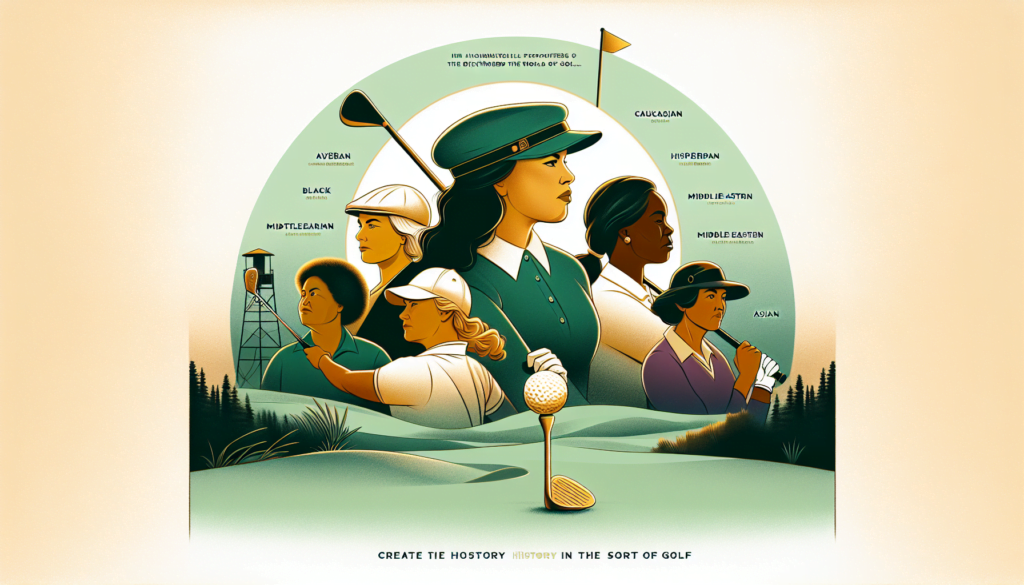Did you know that the history of women in golf is filled with fascinating stories of resilience and determination? From its humble beginnings in Scotland to its rise as a globally beloved sport, women have defied societal norms and made their mark on the greens. Throughout the years, women have faced numerous challenges and barriers, paving the way for future generations of female golfers. In this article, we will explore the rich history of women in golf, from the pioneers who paved the way to the trailblazers who continue to inspire us today. Get ready to discover the untold stories of remarkable women who have left an indelible mark on the world of golf.
Early Beginnings
Women’s Involvement in Early Golfing
In the early days of golf, women had limited participation in the sport. Golf was predominantly seen as a male-dominated activity, and women were often not allowed to play on the same courses as men. However, there were a few exceptions to this norm, and some women were able to explore their love for the game.
Limited Participation in Tournaments
During this time, women faced significant barriers in participating in golf tournaments. Many competitions were exclusively reserved for men, and it wasn’t until later that women were given the opportunity to showcase their skills on a professional level. Despite these challenges, a few remarkable women managed to leave their mark on the history of women’s golf.
Early Female Golfers
Mary Queen of Scots: A Golf Enthusiast
One of the earliest known female golfers was Mary Queen of Scots. Born in the 16th century, Mary was an avid golfer who played regularly during her time as Queen of Scotland. She is said to have introduced golf to France during her reign and played with great passion and skill.
Isabella Macdonald Beaton: The First Woman Golf Course Designer
Isabella Macdonald Beaton became notable for being the first woman to design a golf course. In 1890, she designed the Ladies’ Club Golf Course in North Berwick, Scotland, which quickly gained recognition as a challenging and beautifully crafted course. Her contribution to golf course design was groundbreaking and paved the way for future women in the field.
Dorothy Campbell Hurd Howe: The First American Female Golf Champion
Dorothy Campbell Hurd Howe holds the distinction of being the first American woman to win the U.S. Women’s Amateur Golf Championship in 1909. Her victory marked a turning point for women’s golf in the United States, inspiring many other women to take up the sport and compete at the highest level.

Formation of Women’s Golf Clubs
The Ladies’ Golf Union
The Ladies’ Golf Union (LGU) was founded in 1893 in St Andrews, Scotland. It aimed to promote women’s golf and provide support for female players. The LGU organized championships and established rules for women’s golf. This organization played a crucial role in the development and organization of women’s golf tournaments.
The Women’s Western Golf Association
The Women’s Western Golf Association (WWGA) was established in 1901 and became one of the first regional golf associations in the United States. It aimed to promote women’s golf in the western states and organize tournaments for female players. The WWGA helped to grow the popularity of women’s golf in the United States and paved the way for future advancements in the sport.
Women’s Professional Golf
The Formation of the LPGA
The Ladies Professional Golf Association (LPGA) was founded in 1950, a significant milestone in the history of women’s golf. The LPGA was formed to promote and support professional women golfers and create opportunities for them to compete on a professional level. This organization provided a platform for women to showcase their talents and propelled the growth of women’s golf around the world.
The First LPGA Major Tournaments
The LPGA introduced its first major tournaments in the 1950s. The U.S. Women’s Open, the LPGA Championship, and the Titleholders Championship became highly anticipated events in women’s golf. These tournaments provided women with the opportunity to compete at the highest level and established a tradition of excellence in women’s professional golf.

Pioneering Female Golfers
Mickey Wright: A Dominating Force in Women’s Golf
Mickey Wright, often regarded as one of the greatest female golfers of all time, dominated the golfing scene in the 1950s and 1960s. She won 82 LPGA Tour titles, including 13 major championships. Wright’s exceptional skill and remarkable consistency made her a role model for aspiring female golfers and solidified her place in golf history.
Babe Didrikson Zaharias: Breaking Barriers and Winning Titles
Babe Didrikson Zaharias was an exceptional athlete who excelled in multiple sports, including golf. She won 10 LPGA Tour titles and compiled an impressive resume throughout her career. Zaharias’s achievements not only showcased her talent but also shattered barriers and preconceptions about women’s capabilities in sports.
Annika Sorenstam: Shattering Records and Inspiring a New Generation
Annika Sorenstam rose to prominence in the late 1990s and early 2000s, dominating women’s golf with her exceptional skill and determination. Sorenstam won 72 LPGA Tour titles, including 10 major championships. Her success inspired a wave of young girls to take up golf and pursue their dreams in the sport.
Women’s Golf in the Modern Era
Increased Prize Money and Sponsorship
The modern era has witnessed a significant increase in prize money and sponsorship opportunities for women’s golf. As the popularity of women’s golf grew, so did the financial rewards for successful players. Major tournaments now offer substantial prize purses, reflecting the increased value and recognition of women’s accomplishments in the sport.
Rise of International Talent
The modern era has seen a rise in international talent in women’s golf. Players from countries around the world have emerged as dominant forces in the sport, further diversifying the landscape of women’s golf. This globalization has added to the excitement and competitiveness of the professional circuit.
Growth of Women’s Amateur Golf
The growth of women’s amateur golf has been a testament to the increasing popularity and accessibility of the sport. Amateur championships and college golf programs have provided young women with opportunities to develop their skills and compete at a high level. This grassroots growth has created a strong foundation for the future of women’s golf.
Women’s Golf in the Olympics
The Inclusion of Women’s Golf in the Olympic Games
Women’s golf made its return to the Olympic Games in 2016 after a 112-year absence. The inclusion of women’s golf was seen as a significant step in recognizing and promoting gender equality in sports. The Olympic platform has provided female golfers with a unique opportunity to represent their countries and compete for medals on the global stage.
Medal-winning Performances
Since its reintroduction, the Olympic Games have witnessed memorable medal-winning performances in women’s golf. Golfers such as Inbee Park, Lydia Ko, and Nelly Korda have showcased their skills and represented their countries with pride. These performances have helped elevate the profile of women’s golf and inspire future generations of female golfers.
Advancements in Technology and Training
Equipment and Technology for Women Golfers
Advancements in equipment and technology have benefited women golfers by providing them with tools to enhance their performance. Golf clubs and balls designed specifically for women’s physiology and swing characteristics have made the game more accessible and enjoyable for female players. Additionally, training aids and swing analysis technology have allowed women to refine their techniques and improve their game.
Training and Conditioning Programs
Training and conditioning programs tailored for women golfers have become more prevalent in recent years. These programs focus on improving strength, flexibility, and overall fitness to optimize performance on the course. As a result, women golfers have been able to reach new levels of physical fitness and compete at the highest level.
Challenges and Controversies
Equality and Pay Disparities
Despite the progress made, women’s golf still faces challenges related to gender equality and pay disparities. Female golfers consistently earn less prize money than their male counterparts, and sponsorships and endorsements are often less lucrative for women. The ongoing efforts to address these disparities are crucial for the continued growth and equality in women’s golf.
Discrimination and Bias
Discrimination and bias have been part of the history of women’s golf, with instances of exclusion and unequal treatment. However, the perseverance and success of female golfers have challenged these prejudices, and the golfing community has become more inclusive and supportive of women’s involvement in the sport.
Dress Codes and Gender Stereotypes
Women’s golf has been subjected to dress codes that sometimes reinforce gender stereotypes and place unnecessary restrictions on female players. Efforts have been made to modernize dress codes and create more inclusive policies. The focus should be on allowing players to express themselves while maintaining a respectful and professional appearance.
Promotion and Advocacy for Women’s Golf
Initiatives and Programs Supporting Women’s Golf
Various initiatives and programs have been established to promote and support women’s golf. These include junior golf programs for young girls, scholarship opportunities for aspiring female golfers, and mentorship programs that provide guidance and support for women pursuing a career in golf. These initiatives aim to inspire and empower the next generation of female golfers.
Role Models and Ambassadors
The presence of strong role models and ambassadors in women’s golf has played a vital role in its growth and popularity. Female golfers who have achieved success on and off the course inspire young girls to dream big and pursue their goals. Their accomplishments serve as motivation and encouragement for women to excel in golf and overcome any challenges they may face.
Women’s involvement in golf has evolved significantly over the years, from limited participation to the establishment of professional associations and the inclusion in global competitions like the Olympic Games. The history of women in golf is a testament to their resilience, skill, and dedication to the sport. As the sport continues to progress, it is essential to celebrate and support women’s golf to ensure a bright future for all who love the game.
